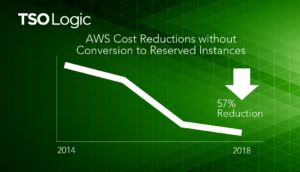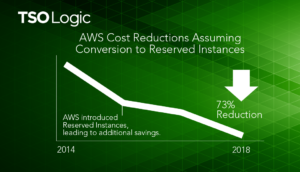Amazon’s Cloud Costs Continue to Fall
The numbers don’t lie, Amazon Web Services continues to reduce costs for its services.
The trend is for a general and widespread drop in the prices of all Cloud Providers, so much so that AWS alone has reduced its prices 60 times in recent years. It remains to be seen whether this is a promotion strategy or the adjustment is structural.
TSO Logic’s new research aims to provide a concrete answer, examining the actual storage provisioning, software license types, and usage levels from a set of anonymous data directly retrieved from servers used in different enterprises. Next, TCO Logic processed those results through its predictive analytics engine to compare current and historical AWS price catalogs.
The Results: The workloads these customers have running in 2017 cost 73% less than the cost to run them in 2014. Details are shown in the table below.
It illustrates the cost of running 100,000 workloads on AWS in 2014 with costs of running workloads similar to those with the same compute and usage patterns over the following three years (we skipped the cloud server products introduced later, which could not be paired with identical instances from previous years). The analysis also calculates the cost savings when using similar payment models, as well as the benefit of using Reserved Instances, which were not available until 2016. The results speak for themselves:


Since 2014, the cost of running enterprise workloads on Amazon’s cloud has dropped by at least 57% when comparing the same payment types (i.e., comparing On-Demand pricing for current and past instances). When the same workload instances are converted from On-Demand pricing to Reserved Instance pricing, which became available in 2016, the savings are up to 73%. Looking at a more recent period, 2015-2017, price declines were still significant. Since 2015, the cost of purchasing the same On-Demand instance has decreased by 14%. When converting to Reserved Instance pricing instead of On-Demand, costs dropped by 46%.
Now with Amazon’s recently announced “Optimize CPUs” option, AWS customers have a new option to save even more. By thinking carefully about your core count, you can now unlock software license savings that potentially undermine infrastructure savings.
The new feature gives you more control over your Amazon EC2 instances on two fronts. First, you can specify a custom number of virtual CPUs (vCPUs) when launching new instances to save on vCPU-based licensing costs. Second, you can disable Intel Hyper-Threading Technology (Intel HT Technology) for workloads that work well with single-threaded CPUs, such as some high-performance computing (HPC) applications.
With the new option, you can disable cores on EC2 instances. For example, a 4xlarge instance, which has 16 vCPUs by default, can be configured with 1-14 vCPUs. The instance price remains the same, but by disabling those cores, you get huge savings when you license SQL, Oracle, and other per-core licensed applications.

Let’s go back to the sincerity of our numbers: A customer was using 1,356 SQL Server cores under license and wanted to bring their SQL license to AWS. Before the new Optimize CPUs feature, they would have had to use 2,220 cores (63% more) on AWS to meet their memory needs. Considering that the list price for Microsoft SQL Server is $14,000 per core, the requirement to count fixed cores would have resulted in a huge spike in licensing costs, effectively making the cloud non-performant for this workload.
Now, that customer can keep the same memory and bandwidth as the full-size instance they need, but they will be able to run SQL Server on AWS with only 1,272 cores, 7% fewer than they are currently using. Running on AWS with 84 fewer cores results in a significant drop in prices compared to the customer’s current environment. More importantly, the flexibility of the core count means that the cloud is now a viable option for your SQL Server. (Note that this analysis adheres to Microsoft’s policy of requiring a minimum of four cores for SQL Server licensing. If this requirement is not enforced, this customer would be able to reduce its core count by an additional 258 cores, further reducing licensing costs).
TSO Logic’s analysis has therefore shown the actual collapse of AWS costs, but what is causing this drastic reduction?
Amazon Web Services is benefiting from a perfect storm of technology optimization, increased efficiency, and improved economies of scale, creating a virtuous cycle for cloud customers of all sizes. AWS works directly with chip manufacturers to create custom models, in the most efficient way possible. This can make a huge difference in costs. Compared to last year’s AWS C4 instances, for example, the latest C5 instances, which use Intel Skylake processors, offer twice the power and performance of vCPUs, 2.4 times the memory, and 3 times the throughput. A single-core Intel processor from 2018 may be able to handle workloads that required dual-core processors just a couple of years ago.
AWS Cloud: The Time Is Now
With the ability to define core counts at a granular level, along with the steady year-over-year decline in AWS instance costs, the cloud is now cheaper than it’s ever been. And if you’ve been thinking about moving Microsoft workloads to AWS, but you didn’t think it would be cost-effective, it’s time to think again. Bottom line: There’s never been a better time to move to the cloud.

Of course, selecting the right AWS options to maximize savings is a complex challenge. To take advantage of continuous improvements in processing power and price reductions, you can’t migrate once and forget about it.
You need to continually identify the best and most cost-effective instance type for your job. To maximize your software license savings, you need to understand which of your existing licenses can be transferred, as well as the best instance type and configuration to use.
Design, implementation, monitoring and updating have been our bread and butter for the past 10 years, and we do it with passion for each of our customers. Our partnership with Amazon Web Services has allowed us over the years to increase our skills and our ability to create solutions tailored to the ever-changing needs that customers submit to us.
Contact us today and we’ll help you quickly determine the most effective path to the cloud.
Sources:
